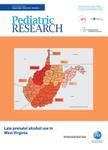版权所有:内蒙古大学图书馆 技术提供:维普资讯• 智图
内蒙古自治区呼和浩特市赛罕区大学西街235号 邮编: 010021

作者机构:Univ Oulu Dept Pediat FIN-90220 Oulu Finland Univ Calif Irvine Dept Pediat Div Neonatal Med Irvine CA 92717 USA Univ Calif Irvine Dept Community & Environm Med Irvine CA 92717 USA Vanderbilt Univ Dept Pediat Div Neonatal Med Nashville TN USA
出 版 物:《PEDIATRIC RESEARCH》 (儿科研究)
年 卷 期:1999年第45卷第2期
页 面:247-254页
核心收录:
学科分类:1002[医学-临床医学] 100202[医学-儿科学] 10[医学]
主 题:投药 吸入 方差分析 动物 新生 支气管肺泡灌洗 支气管肺泡灌洗液/化学 孕龄 谷胱甘肽/代谢 高氧症/病理生理学 巨噬细胞 肺泡/药物作用 巨噬细胞 肺泡/生理学 一氧化氮/投药和剂量 一氧化氮/药理学 肺泡/药物作用 肺泡/代谢 肺表面活性剂/代谢 参考值 呼吸爆发 动物 兔
摘 要:Inhaled nitric oxide (iNO) is a specific pulmonary vasodilator. By serving as a pro-oxidant or antioxidant, iNO may influence other pulmonary functions as well. This study was designed to test the hypothesis that iNO affects the alveolar lining after premature birth. Preterm rabbits (gestation 29 d, term 31 d) were nose-only exposed NO (14 ppm) and 98% O-2 for 20 h. The others were exposed to either 98% O-2 or air. In another experiment, premature rabbits were exposed to either NO in air or to air. After the exposure, bronchoalveolar lavage (BAL) was per formed and the surfactant aggregates were isolated. The surfactant components and surface activity were analyzed. In total, 144 animals were studied. There were no significant differences in the number, distribution, or respiratory burst activity of cells recovered by BAL. Neither brief hyperoxia nor iNO increased plasma-derived proteins in BAL. Exposure to O-2 decreased large surfactant aggregates, surface activity, and the content of surfactant protein B in BAL, whereas iNO prevented completely or partially these effects of acute hyperoxia on surfactant. Hyperoxia increased the content of malondialdehyde and decreased glutathione in epithelial lining fluid. iNO decreased malondialdehyde (p 0.05) and tended to increase glutathione (p = 0.06) in animals breathing O-2. Nitrotyrosine was not detectable in BAL, and NO2 was low in the breathing area. In room air, iNO had no significant effect on surfactant. According to the present results, a brief period of hyperoxia causes an oxidant stress and decreases the surface activity of alveolar surfactant in premature rabbits. In contrast, a low dosage of iNO decreased or prevented the O-2-induced detrimental effects on alveolar surfactant and alleviated the oxidant stress.